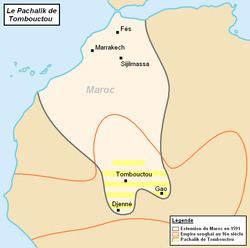1591–1833 → Disestablished 1833 Capital Timbuktu | Established 1591 Today part of Mali | |
 | ||
Government Moroccan Pashalik (1591–1603)
Nominally vassal state of Morocco (1603–1826)
Tributary state of the Tuaregs (1787–1833) | ||
The Pashalik of Timbuktu was a West African political entity that existed between the 16th and the 19th century.
History
By the end of the 16th century, Moroccan sultans were strengthened after the completion of the reunification of Morocco and the victory over the Portuguese at the Battle of the Three Kings, but their financial needs lead them to extend their realm southward to Saharan gold mines and Songhay territories.
In 1577, a Moroccan expedition occupied Taghaza. In 1582, a first expedition to Timbuktu was defeated.
In 1591, a Moroccan expeditionary force defeated the Songhay army at Tondibi and conquered Gao, Timbuktu and Djenné. The Pashalik of Timbuktu was then established and Timbuktu became its capital.
Starting from 1618, the Pasha, who was then appointed by the Sultan of Morocco, became elected by the Armas. However, while governing the Pashalik as an independent republic, the Armas continued to recognize Moroccan sultans as their leaders. During the civil war that followed the death of Ahmad al-Mansur in Morocco, the Pashalik supported the legitimate Sultan, Zidan al-Nasir, and in 1670 they recognized the Alaouite sultans and pledged allegiance.
By the middle of the eighteenth century, the pashalik was in total eclipse. In about 1770, the Tuareg took possession of Gao, and in 1787 they entered Timbuktu and made the Pashalik their tributary.
